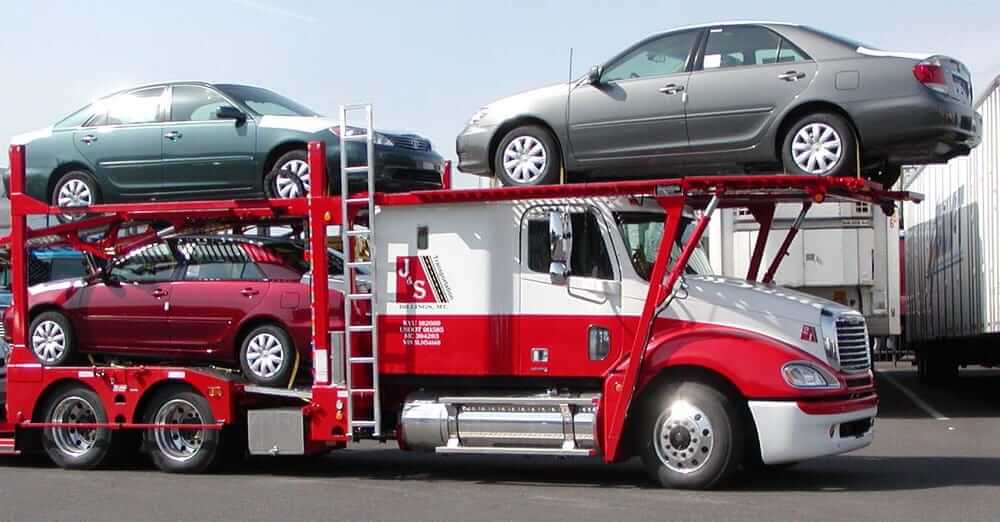When you ship a car it is loaded on a trailer. There are three main types of trailers – there are single level car trailers, multilevel trailers, and flat beds. A top load simply means your car is loaded on the top of a multilevel trailer as shown in the picture above. When you request a top load, you are asking the driver to put your vehicle on the “upper deck,” or on the top level of the trailer.
Advantages and Disadvantages of Top Load Car Shipping
The primary advantage to top load car shipping is that your vehicle is farther away from the road, providing your car maximum protection from rocks and road debris.
Another advantage is that it protects your car from potential fluid leaks from cars that would otherwise be parked above it.
The disadvantage of top load car shipping is that your vehicle is more exposed to the elements of nature, particularly hail. This type of damage is extremely rare for auto transports, but it does happen occasionally. If hail strikes, the cars on the top of the trailer are taking the hit – literally.
Top load transports can also take longer to complete. Finding a carrier with an empty spot on the top level of a trailer can be challenging. After all, there are only so many top spots available on a trailer. Carriers on Central Dispatch may be interested in a transport but if it requires a top load and they don’t have a top spot available, they obviously can’t take the assignment. You may have to wait a little while longer to find a carrier that has a top load slot available on your route.
Another disadvantage is that when a top load slot is available, you’ll pay extra for it, usually $150-$200 more depending on the carrier or broker doing the transport.
Is Top Load Car Shipping an Option?
We no longer offer top-load car shipping as an option. We used to but the requests for them were so infrequent and when they occasionally came up, we had a hard time getting transports done as quickly as we like to. As I mentioned earlier, top load slots are sometimes hard to find. We normally get our vehicles picked up within a week from when they are available but top load transports can take up to ten days or longer.
If we are working with a customer that wants a top load slot, we encourage them to go with enclosed car shipping. Otherwise, we do our best to accommodate a top load request by working with the driver, but we don’t guarantee one.
How Do You Prevent Cars From Leaking Fluids on the Cars Below Them?
When customers inquire about top load car shipping, they are usually concerned about their cars being leaked on from cars above them. This is a legitimate concern but let me put your mind at ease.
We do thousands of transports every year and I can’t remember the last time we had a damage claim due to fluids leaking from cars above. It just doesn’t happen that often.
Drivers don’t want your car leaked on anymore than you do. If your car is damaged from leaking fluids above it, the driver will ultimately be held responsible. Drivers don’t want that grief so they are very careful about the cars they put on the top deck. If they have any concerns about a car potentially leaking fluids, they will not put it on the top level.
Side Note on fluid leaks: One of the requirements we have with any vehicle we transport is that it doesn’t leak fluids. This is a standard requirement by most carriers and brokers. Drivers will typically refuse to ship vehicles that leak fluids.
Also, not every trailer on the road is a multilevel trailer. In fact, there are probably more single level and flatbed trailers on the road than double-decker car trailers. You likely won’t even have to worry about fluid leaks from a car parked above your car because there won’t be a top deck!
You might be wondering, could I use a car cover during shipping to protect my car from fluid leaks above? Unfortunately, no. It’s nearly impossible to keep car covers intact during a shipment given the sheer force of the wind generated during a transport. And if they do stay intact, they can actually cause damage to a car as they may rub the paint or scratch the car.
If you’re thinking about a top load shipment because you’re concerned about rocks and road debris, keep in mind the front of the driver’s truck and the trailer itself takes the bulk of the abuse – not the vehicles on the trailer. Rocks and debris tend to hit the truck or trailer and bounce away, or they bounce underneath the truck and trailer.
Final Thoughts on Top Load Car Shipping
If you want maximum protection of your vehicle during an auto transport, enclosed shipping is the best option. If you want your car to be totally protected from rocks, road debris, and weather, nothing beats enclosed transportation, but it comes with a price. You’ll pay at least 50% more for enclosed transportation, which is why this option is usually reserved for those that own exotic or rare vehicles, or classic restored vehicles.
If enclosed shipping isn’t in your budget, don’t fret. Vehicle damage on open trailers is rare whether your car is on the top or bottom deck of the trailer. Our damage rate is less than 1%! And in the rare event damage does occur, we have an efficient damage claim process in place and your vehicle will be covered by the carrier’s cargo insurance.

